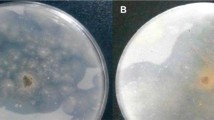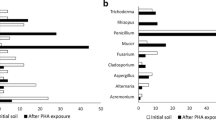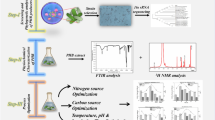Abstract
Systematic screening of 45 soil fungi for degradation polyhydroxyalkanoic acids (PHAs) has led to the selection of 6 potent Aspergillus isolates belonging to A. flavus, A. oryzae, A. parasiticus, and A. racemosus. Degradation of PHAs as determined by tube assay method revealed that these Aspergillus spp. were more efficient in degrading poly(3-hydroxybutyrate) [P(3HB)] compared to copolymer of 3-hydroxybutyric acid and 3-hydroxyvaleric acid (P3HB-co-16% 3HV). Moreover, the extent of degradation in mineral base medium was much better than those in complex organic medium. For all the Aspergillus spp. tested, maximum degradation was recorded at a temperature of 37°C with significant inhibition of growth. The optimum pH range for degradation was 6.5–7.0 with degradation being maximum at pH 6.8. The extent of polymer degradation increased with increase in substrate concentration, the optimum concentration for most of the cultures being 0.4% and 0.2% (w/v) for P(3HB) and P(3HB-co-16%3HV) respectively. Supplementation of the degradation medium with additional carbon sources exerted significant inhibitory effect on both P(3HB) and P(3HB-co-16%3HV) degradation.



Similar content being viewed by others
References
Steinbüchel A (1991) In: Byrom D (ed) Biomaterials, MacMillan Publishers, London, p 123
Brandl H, Gross RA, Lenz RW, Fuller RC (1990) Adv Biochem Eng Biotechnol 41:77
Brandl H, Bachofen R, Mayer J, Wintermantel E (1995) Can J Microbiol 41(suppl 1):143
Chowdhury AA (1963) Arch Microbiol 47:167
Delafield FP, Doudoroff N, Palleroni NJ, Lusty J, Contopoulos R (1965) J Bacteriol 90:1455
Brandl H, Püchner P (1992) Biodegradation 2:237
Mergaert J, Anderson C, Wouters A, Swings J, Kersters K (1992) FEMS Microbiol Rev 103:317
Mergaert J, Webb A, Anderson C, Wouters A, Swings J (1993) Appl Environ Microbiol 59:3233
Manna A, Giri P, Paul AK (1999) W J Microbiol Biotechnol 15:705
Manna A, Paul AK (2000) Biodegradation 11:323
Jendrossek D, Schirmer A, Schlegel HG (1996) Appl Microbiol Biotechnol 46:451
Matavulj N, Molitoris HP (1992) FEMS Microbiol Rev 103:323
Mc Lellan DW, Halling PJ (1988) FEMS Microbiol Lett 52:215
Lepidi AA, Nuti MP, Bertoldi M (1972) Agric Ital (Pisa) 72:166
Neumier S (1994) Diploma Thesis. Universitat Regensburg. p 99
Mergaert J, Glorieux G, Hauben L, Storms V, Mau M, Swings J (1996) System Appl Microbiol 19:407
Matavulj M, Molitoris HP (1991) Abstr Tagung Sekt Mykol Dtsch Bot Ges, Bayreuth FRG
Kim DY, Rhee YH (2003) Appl Microbiol Biotechnol 61:300
Nam JS, Kim HC, Kim DY, Rhee YH (2002) Proc Int Symp Genet Ind Microorg 9:192
Matavulj M, Moss ST, Molitoris HP (1993) Proc Int Sym Bact PHA p 465
Mergaert J, Wouters A, Anderson C, Swings J (1995) Can J Microbiol 41:154
Kim MN, Lee AR, Yoon JS, Chin IJ (2000) Eur Polym J 36:1677
Mergaert J, Webb A, Anderson C, Swings J (1994) J Environ Polym Degrad 2:177
Gonda KE, Jendrossek D, Molitoris HP (2000) Hydrobiologia 426:173
Pal S, Manna A, Paul AK (2000) Folia Microbiol 43:177
Malik KA, Claus D (1978) J Appl Bacteriol 45:143
Doi Y (1990) Microbial polyesters. VCH Publishers, New York
Scherer Y (1996) Ph. D. Thesis, University of Massachusetts, Ahmerst
Iyer S, Shah R, Sharma A, Jendrossek D, Desai A (2000) J Polym Environ 8:197
Jendrossek D, Knoke I, Habibian RB, Steinbuchel A, Schegel HG (1993) J Environ Polymer Degrad 1:53
Neumeir S (1997) Ph. D. Thesis, Universitat Regensburg. p 148
Acknowledgments
This work was supported by the financial assistance from the Council of Scientific and Industrial Research, New Delhi.
Author information
Authors and Affiliations
Corresponding author
Rights and permissions
About this article
Cite this article
Sanyal, P., Samaddar, P. & Paul, A.K. Degradation of Poly(3-hydroxybutyrate) and Poly(3-hydroxybutyrate-co-3-hydroxyvalerate) by Some Soil Aspergillus spp.. J Polym Environ 14, 257–263 (2006). https://doi.org/10.1007/s10924-006-0022-7
Published:
Issue Date:
DOI: https://doi.org/10.1007/s10924-006-0022-7




